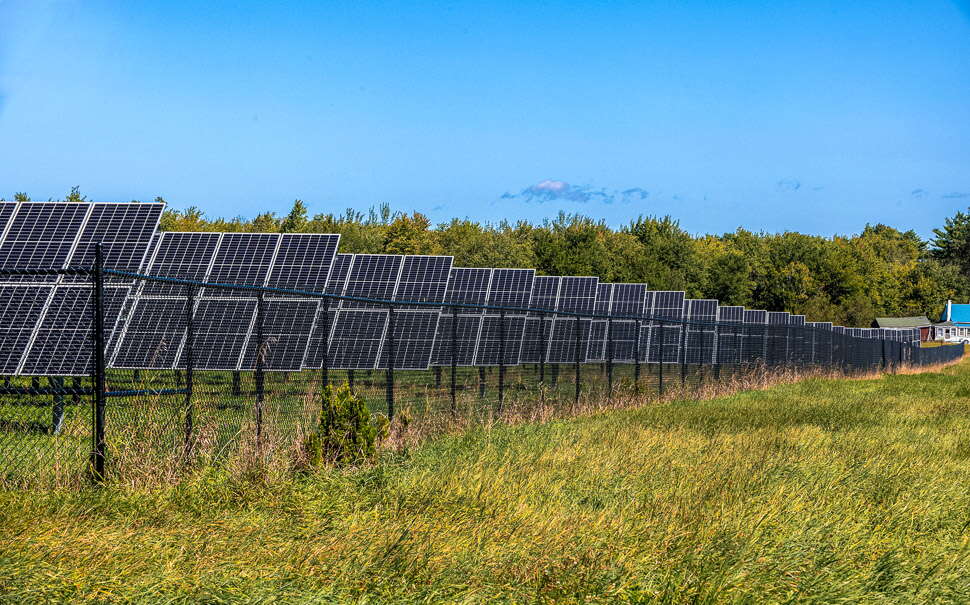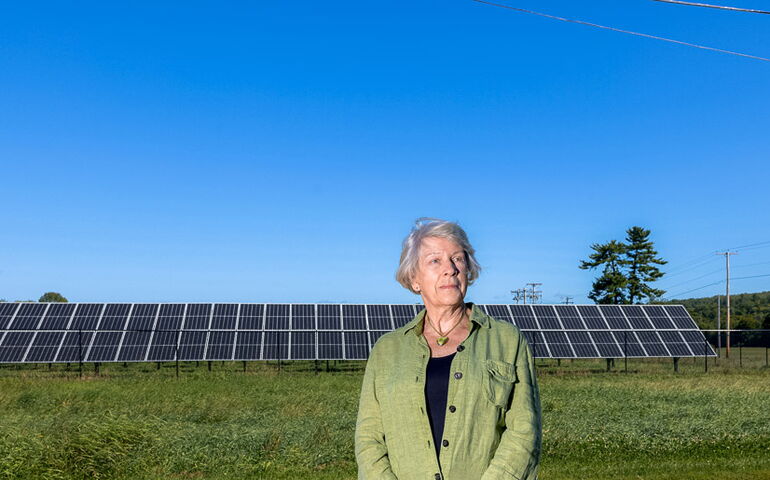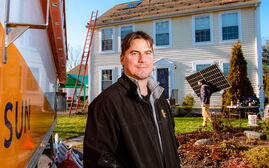
Processing Your Payment
Please do not leave this page until complete. This can take a few moments.
Solar arrays have been a boon for farmers, but concern is growing over loss of farmland
 Photo / Tim Greenway
Evelyn Norton is co-owner of the 135-acre Souther Farm in Livermore Falls, where ReVision Energy leases about 20 acres of the farm for a solar array.
Photo / Tim Greenway
Evelyn Norton is co-owner of the 135-acre Souther Farm in Livermore Falls, where ReVision Energy leases about 20 acres of the farm for a solar array.
Nowadays, one doesn’t have to drive far to find a solar project in Maine.
That wasn’t the case even a decade ago, when solar projects were almost entirely constrained to residential properties. But that was before state lawmakers passed legislation in 2019 expanding net energy billing and updating Maine’s renewable portfolio standard, increasing the amount of renewable power that had to be sold in the state.
Those measures worked like jet fuel for Maine’s solar industry, with the state seeing substantial annual jumps in its installed solar capacity.
Net energy billing led to “an explosion of solar projects interconnecting to the distribution system,” says Philip Bartlett, the chair of the Maine Public Utilities Commission, adding that many of the projects selected to fulfill the renewable portfolio standard mandate were solar projects, too.
Totaling roughly 1,108 megawatts as of the first quarter, the Solar Energy Industries Association projects Maine will see 1,643 MW within the next five years. SEIA, the sector’s national trade group, reports that total solar investments in the state have hit $1.8 billion.
Weighing the concerns
But as solar development has risen in Maine, so too have concerns that many of the ground-mounted solar facilities are taking up agricultural land. It’s a rising concern not just in Maine or the U.S. but around the world.
A 2022 report from the American Farmland Trust found that if development patterns — including not just solar but low-density residential, commercial and industrial uses — across the state continued into 2040, “53,400 acres of Maine’s farmland will be paved over, fragmented, or converted to uses that jeopardize agriculture,” about half of which would be on “Maine’s best land.”
To that end, state lawmakers passed a bipartisan law last year directing the Department of Agriculture, Conservation and Forestry to come up with a permitting process for renewable energy projects that would be built on high-value agricultural land.
LD 1881 also makes the agency determine how much compensation developers would owe the state for farmland conservation efforts if they do decide to build on such properties, based on factors like its active farming history, although the Department of Environmental Protection will calculate the actual fees.
Under the rule as proposed, a state-licensed soil scientist would have to identify if high-value agricultural land is present on a proposed solar site. If so, the agency would require an additional study to see if the project could be amended in some way — perhaps by shifting or relocating its footprint — before seeking a permit, although a permit-by-rule could be granted to projects of less than 20 acres or on farmland impacted by harmful chemicals known as PFAS.
Developers could reduce how much compensation they owe if they incorporate dual-use or agrivoltaic features, like sheep grazing or crop production, for up to 300 MW of a given solar project on high-value agricultural land.
The DACF notes in a memo on its proposed rule that most solar projects won’t be impacted since “only ~13% of Maine would be designated as [high-value agricultural land]” based on the amount of lands classified by the U.S. Department of Agriculture as prime farmland, farmland of statewide importance or locally valuable farmland.
But what farmland would be considered “high-value” became a point of concern during the rulemaking’s public comment period, essentially boiling down to the idea that one farmer’s trash might be another’s treasure.
Numerous commenters at an Aug. 19 public hearing on the rulemaking says the definition would limit their income-generation potential, while others were concerned about what the definition would consider.
Julie Ann Smith, a lobbyist with the Maine Farmers Coalition, says her organization was concerned by “the lack of involvement of the farmers and the landowners in this process.” She suggested that soil testing alone wouldn’t show the full picture of how useful a plot is, using the example that soil could test well but not produce much because of how wet the area is.
“There is a much broader perspective that needs to be included when you are considering what prime agricultural land looks like,” says Smith. “It is much more complex than just the soil itself; there are a lot of factors that go into it.”
Contentious issue
State Rep. Scott Landry, D-Chesterville/Farmington, co-sponsor of the bill, says that he hadn’t thought that defining high-value agricultural land would be as contentious as it is, pointing to the legislation’s bipartisan backing.
“We realize the farmers need this [additional revenue stream], but the way I look at it, all of their land is not prime, it’s not going to fit into that category,” says Landry, who lives on a small farm himself.
“Don’t use the best cropland … to put these in if you’ve got a rocky slope with a southern exposure you could use instead. But the developers are going to have to put some work and money into declaring it and, you know, straightening it out so they can use it.”

He noted that he’s a strong supporter of renewable energy, adding that he’s in the process of adding solar to his own home. But several solar company owners expressed concern that the rules would now make it more expensive to develop projects in Maine, additional costs they warned would eventually be passed down to ratepayers.
Chris Byers, the owner of Branch Renewable Energy, was among them, remarking at the hearing that the rule appeared to unfairly “cherry pick” on solar as a threat to farmland. He says timber harvesting or large home developments would not face similar compensation requirements despite not incorporating any dual-use agricultural features.
“It’s just strange that there’s such targeted rulemaking of solar projects for this that will result in impact to a further loss of farmland,” he says. “I believe that these projects offer the ability for these farms to stay under ownership by their original owners” while also earning alternate revenue streams.
A Livermore Falls farm balances opportunities
That sentiment is shared by Evelyn Norton. She and her sister co-own the Souther Farm in Livermore Falls, but ReVision Energy leases about 20 acres of the 135-acre farm for a solar array. (The developer connected Mainebiz with Norton for this article.)
The bulk of that power goes toward local schools, but the income helps the family keep the rest of their acreage.
Norton is against the compensation rules, saying the higher costs will “eliminate a lot of projects” from getting across the finish line and prevent other farms from earning a livable income.
“You shouldn’t have to be penalized for making that kind of decision of what you want to do with your land,” she say. She’s frustrated that housing developments and other types of projects on farmland won’t face the same financial mitigation requirement.
But not all farmers appear to share Norton’s concern.
Heather Spalding, deputy director of the Maine Organic Farmers and Gardeners Association, says the land-use mitigation fees would actually help reduce costs for farmers. She says that the reduction in farmland tied to solar developments are “driving up the value of existing farmland, driving up property taxes. Spalding did not respond to an interview request.
“We recognize that farmers’ wealth is tied up in the value of their land and, in some cases, farmers need access to that income from solar development … as they near retirement,” Spalding said at the hearing. She added that the mitigation fee “balances the opportunity” of solar development with protecting “the most valuable soils.”













0 Comments